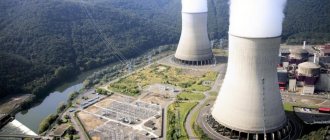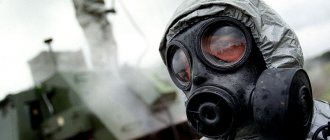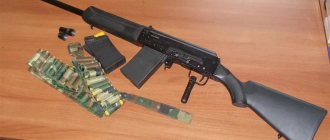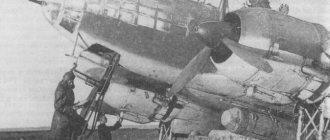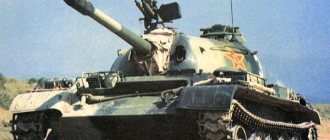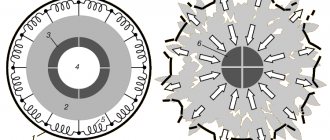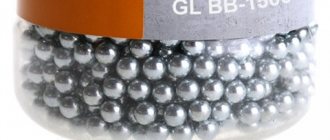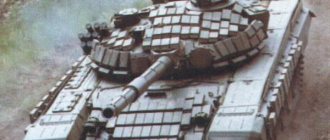Chemical weapons were invented and used at the beginning of the twentieth century for the mass extermination of soldiers and civilians using poisonous gases and liquids. Chemical weapons consist of the poisonous and toxic components themselves, as well as the means by which they are delivered and used. We bring to your attention several ways to protect yourself from chemical weapons.
Chemical weapons are among the most brutal weapons, affecting large numbers of people and causing horrific, prolonged suffering before death or injury. It was for these reasons that it was banned back in 1925. However, to date, not all countries in the world have destroyed their stockpiles of chemical weapons and the threat of their use has not been completely eliminated, despite the measures taken. That is why it is necessary to know what these weapons are and how to protect against chemical weapons.
Methods of protection against chemical weapons briefly:
Introduction
Chemical weapons are weapons of mass destruction based on the toxic properties of toxic substances (TS) and their means of delivery: Artillery grenades, rockets, mines, aircraft bombs, gas guns, gas cylinder launchers, UAR (Airborne Discharge Devices), grenades, sketches. Together with nuclear and biological (bacteriological) weapons, these are weapons of mass destruction (WMD).
Poisonous Substances (PS) are chemical compounds that, when used, can cause damage to unprotected life force or reduce their fighting ability.
Weapons of mass destruction differ from other combat vehicles by their distinctive characteristics: They are capable of penetrating through the air into various structures, tanks and other military equipment and hitting the people in them; they are able to maintain their effect in the air, on the ground and in various objects for some, sometimes quite a long time; they spread in large quantities through the air and over large areas and affect all people within their borders without protective equipment; OAS vapors are capable of spreading in the direction of the wind at significant distances from non-destructive areas; they are able to penetrate large areas through the air.
Chemical munitions have the following characteristics:
- durability of the chemical agents used;
- the nature of the physiological effects of PB on the human body.
- about means and methods of application;
- for tactical purposes;
- start speed.
Depending on how long the toxins retain their harmful effects after application, they are conventionally divided into:
- elastic;
- unbalanced.
The persistence of toxic substances depends on their physicochemical properties, method of application, meteorological conditions and the type of area in which the toxic substances are used.
Long lasting PB maintains its amazing effects for hours, days and even weeks. They evaporate very slowly and are practically unchanged by exposure to air or moisture.
An unstable PS retains its striking effect in open areas for several minutes, and in places of stagnation (forests, depressions, engineering structures) - from several tens of minutes or more.
Signs of the use of toxic substances
When an ammunition filled with toxic substances explodes, it releases a cloud of yellowish or white vapor or fog into the air. It spreads with the wind over long distances almost at lightning speed, penetrating military equipment, shelters and houses. It is impossible to hide from this poisonous cloud.
Sometimes a chemical attack is carried out using liquid toxic substances - then they pour out of the aircraft, representing a dark streak. Toxic rain settles on the grass and trees in an oily film.
Physiological effects
Depending on the type of impact on the human body, toxins are divided into five groups:
- nervous activity;
- Blister on the skin;
- often poisonous;
- Suffocating;
- psychochemical effect.
Nerve toxins cause damage to the central nervous system. According to the US Army command, such a PS should be used to defeat an unprotected enemy worker or to surprise a worker wearing gas masks. In the latter case, this means that the personnel will not have time to use gas masks in time. The main purpose of using nerve gas is to quickly and en masse incapacitate personnel with as many lethal consequences as possible.
Chemicals that cause skin blisters are added primarily through the skin, and when used as aerosols and vapors, also through the respiratory system.
General toxic OM affects the respiratory system, which stops oxidative processes in the tissues of the body.
Choking mainly affects the lungs.
PS having a psychochemical effect appeared in the arsenal of a number of foreign countries relatively recently. They are capable of shutting down the enemy’s vital functions for some time. These toxic substances, acting on the central nervous system, disrupt normal mental activity of a person or cause mental disabilities such as temporary blindness, deafness, anxiety, and limitation of motor functions of various organs. It is characteristic of these substances that they require 1000 times higher doses to cause fatal injury than to cause disability.
According to the US, PS, along with deadly poisons, is said to weaken the will and steadfastness of enemy troops in battle.
Consequences of a chemical attack
Any use of toxic substances leads to dire consequences for all living things. Immediately after the use of chemical weapons, a damage zone is formed, which has the following characteristics:
- fatal injury to people and animals caught in the epicenter of the explosion;
- damage to living organisms located far from the epicenter in the open air;
- defeat of people and animals hiding in a shelter at a distance from the source of damage;
- contamination of residential areas, economic facilities and infrastructure;
- powerful moral impact.
Of course, this is a fairly general characteristic. After all, it is possible to predict the consequences of using toxic substances only by knowing what type they are.
Means and methods of application
According to army military experts, toxic substances can be used for the following purposes:
- victory over living violence with the goal of its complete destruction or temporary cessation, achieved mainly through the use of nerve gas
- Suppression of live violence in order to force them to take protective measures for a certain period of time, which makes maneuvering difficult, reducing the speed and accuracy of fire; this task is performed using skin and bladder, as well as nerve agents;
- Bonding (depletion) of the enemy in order to complicate his combat operations for a long time and cause casualties among personnel; this problem is solved by using persistent chemicals;
- Contamination of terrain with the purpose of forcing the enemy to abandon his positions, to prevent or impede the use of certain terrain, and to overcome obstacles.
The army can be deployed to solve these problems:
- Rockets;
- Aviation;
- Artillery;
- chemical vapors.
The defeat of the vital force is intended through massive attacks on chemical munitions, especially with the help of multi-barrel rocket launchers.
Investigation into the Syrian tragedy
The entire Internet is replete with photographs of victims of chemical attacks. Here and there, video interviews of Syrians appear, talking about the brutal Bashar al-Assad and his regime. Naturally, in connection with all the accusations thrown at it, official Damascus felt the need to conduct an independent investigation into the chemical attack.
However, it is difficult to prove that you are right when people do not want to see the obvious. For example, attentive Internet users noticed discrepancies in the videos about the attack with the statement about the time of the attack. It is also unclear where the photo of nine dead children in the back of a truck came from on the eve of the alleged attack. All this requires careful study and verification, because it is unknown whether the spraying of toxic substances was intentional, or whether it was a tragic accident that claimed the lives of several dozen innocent people.
Properties of the main toxic substances
Currently, the following chemicals are used as chemical agents:
- sarin;
- Soman;
- V-gases;
- Mustard gas;
- Fetid acid;
- Phosgene;
- Lysergic acid dimethylamide.
Sarin is a colorless or yellow liquid with virtually no odor, making it difficult to recognize by appearance. It belongs to the class of nerve agents. Sarin is intended primarily to contaminate the air with vapors and fog, i.e. as an unstable chemical agent. In some cases, however, it can be used in a droplet to contaminate the area and military equipment located on it; in this case, the resistance of sarin can be as follows: in summer - several hours, in winter - several days.
Sarin causes damage through the respiratory system, skin, and gastrointestinal tract; acts through the skin in a droplet-liquid and vapor state, without causing local damage. The degree of sarin contamination depends on its concentration in the air and the time of its appearance in the contaminated atmosphere.
When exposed to sarin, an affected person experiences salivation, excessive sweating, vomiting, dizziness, loss of consciousness, seizures with severe convulsions, paralysis and, as a result, severe poisoning, death.
Soman is a colorless and almost odorless liquid. It belongs to the class of nerve agents. In many ways it is very similar to sarin. Soman's resistance is slightly higher than that of Sarin, and it has about 10 times more powerful effects on the human body.
V-gases are slightly volatile liquids with a very high boiling point, so their resistance is many times higher than that of sarin. Like Sarin and Soman, these are nerve poisons.
According to the foreign press, V-gases are 100-1000 times more toxic than other nerve gases. They are highly effective when applied through the skin, especially in a droplet-liquid state: exposure of human skin to small droplets of V-gas is usually fatal.
Mustard is a dark brown oily liquid with a characteristic odor similar to garlic or mustard. It belongs to the skin irradiation class.
Mustard gas slowly evaporates from contaminated areas; its stability at ground level is: in summer - from 7 to 14 days, in winter - a month or more.
Mustard gas has a multi-level effect on the body: in the state of droplet liquid and vapor it affects the skin and eyes, in vapor it affects the respiratory tract and lungs, when food and water inside the body enter the digestive organs. The effect of mustard gas does not appear immediately, but only after some time, which is called the period of hidden actions.
Upon contact with the skin, drops of mustard gas are quickly and painlessly absorbed into the skin. After 4-8 hours, redness and itching appear on the skin. At the end of the first and beginning of the second day, small bubbles form, which then merge into separate large bubbles filled with a yellow amber liquid, which becomes cloudy over time. The appearance of bubbles is accompanied by malaise and fever. After 2-3 days, the blisters burst and reveal hidden ulcers that do not heal for a long time. If the infection gets into the ulcer, suppuration occurs and the healing period is extended to 5 - 6 months.
Even at low concentrations in the air and an exposure duration of 10 minutes, the organs of vision are exposed to mustard gas. The latent period is from 2 to 6 hours, then signs of damage appear: a feeling of sand in the eyes, photophobia, tears. The disease can last from 10 to 15 days, after which recovery begins.
The cause of infection of the digestive system is contamination of food and water with mustard gas. In severe cases of poisoning, after a period of latent exposure (30 - 60 minutes), there are signs of damage: False pain, nausea, vomiting, then general weakness, headache, weakened reflexes, discharge from the mouth and nose acquires a stinking odor. The process continues: paralysis sets in, severe weakness and exhaustion occur. In an unfavorable course, death occurs within 3–12 days as a result of complete loss of strength and exhaustion.
Vinyl acid is a colorless liquid with a specific odor similar to the smell of bitter almonds; in small concentrations the odor is difficult to distinguish. Vinyl acid evaporates easily and is only effective when evaporated. We are talking about obstetrics with a generally poisonous effect.
Typical signs of foul acid damage are a metallic taste in the mouth, throat irritation, dizziness, weakness, and nausea. Then painful shortness of breath, slow pulse, the poison loses consciousness, and acute spasms appear. Seizures are observed for a relatively short time, they are replaced by complete relaxation of muscles with loss of sensitivity, a drop in temperature, suppression of breathing, followed by cessation of breathing. Cardiac activity after respiratory failure continues for 3-7 minutes.
Phosgene is a colorless, volatile liquid with the aroma of untouched hay or rotten apples. It acts on the body in a vaporized state. It belongs to the class of agents with a suffocating effect.
Phosgene has a latent duration of action of 4-6 hours, its duration depends on the concentration of phosgene in the air, the time spent in a polluted atmosphere, the condition of the person and the cooling of the body.
When phosgene is inhaled, a person experiences a sweet, unpleasant taste in the mouth, followed by coughing, dizziness and general weakness. When they leave the contaminated air, the symptoms of poisoning quickly pass and a period of so-called “apparent well-being” begins. But after 4 - 6 hours, the affected person experiences a serious deterioration: rapidly developing cyanosis of the lips, cheeks, nose, general weakness, headache, rapid breathing, acute shortness of breath, painful cough with the release of fluid, foamy, pink sputum indicates the development of pulmonary edema. The process of phosgene poisoning reaches its peak within 2-3 days. With a favorable course of the disease, the patient's health gradually improves, and in severe cases of damage, death occurs.
Lysergic acid dimethylamide is a toxic substance with psychochemical effects.
After 3 minutes, mild nausea and dilated pupils occur, followed by auditory hallucinations that last for several hours.
Toxins as chemical weapons killers...
Toxins are chemicals from plant, animal or microbial proteins that are highly toxic. Characteristic representatives of this group: Botulinum toxin - one of the most powerful deadly poisons, which is a product of bacterial activity, staphylococcal entrotoxin, ricin - a toxin of plant origin.
The factor of the impact of chemical weapons is the toxic effect on the human body and animals, quantitative properties - concentration and toxodoses.
Toxic chemicals—phytotoxicants—are said to affect different types of vegetation. For peaceful purposes, they are primarily used in agriculture to control weeds, defoliate vegetation, speed up the ripening of fruits, and facilitate harvesting of crops (such as cotton). Depending on the nature of their effect on plants and their purpose, phytotoxicants are divided into herbicides, arboricides, aphids, defoliants and desiccants. Herbicides are intended for the destruction of herbaceous vegetation, arboricides - for tree and shrub vegetation, algaecides - for aquatic vegetation. Defoliants are used to remove leaves from vegetation, and desiccants act on vegetation by drying it out.
The use of chemical weapons, as in the case of an accident with the release of OX B, creates zones of chemical contamination and foci of chemical damage (Fig. 1). The zone of chemical contamination with chemical warfare agents includes the area where the chemical warfare agents were used and the zone over which a cloud of contaminated air with infectious concentrations has spread. A chemical contamination hotspot is an area where massive losses of people, farm animals and plants have occurred as a result of the use of chemical weapons.
The characteristics of contaminated and affected areas depend on the type of toxic substance, means and methods of application, as well as meteorological conditions.
Weapons of mass destruction: formulation
Chemical weapons refer to a special type of weapon, which is based on the use of various chemical substances. These include poisonous substances and toxins that can have an effect on all living organisms, including plants within the affected radius. After using such weapons, not only people die, but also the earth itself. It is known that in Vietnam, in those places where the Americans used poisonous substances, nothing still grows, and children are born with numerous mutations.
Modern scientists believe that a chemical attack can lead to a real environmental disaster that will affect every inhabitant of the planet. Therefore, many scientific communities speak out against any development of chemical weapons designed to find new toxic substances and increase their range of destruction.
Modern methods of protection against chemical weapons
Chemical weapons include toxic substances (0B) and their means of delivery. Rockets, aircraft bombs, artillery shells and mines are equipped with toxic substances.
According to its effects on the human body, 0B is divided into nerves, skin and blisters, suffocating, toxic, irritating and psychochemical.
Then it is necessary to briefly characterize the main groups of toxic substances and their effects on the human body.
Nerve gas: VX (V-Ix), sarin. Damage to the nervous system when exposed to the body through the respiratory tract, when vapors and droplets enter the liquid state through the skin and when entering the gastrointestinal tract with food and water. In summer they resist for more than one day, in winter - for several weeks and even months. These 0B are the most dangerous. A very small amount of them is enough to hit a person.
these are signs of damage: salivation, constriction of the pupils (miosis), difficulty breathing, nausea, vomiting, convulsions, paralysis.
Gas masks and protective clothing are used as personal protective equipment. To provide first aid, put on a gas mask and inject it using a tubular syringe or tablet. If the nerve agent damages skin or clothing, the affected area is treated with liquid from an Individual Chemical Packet (IPP).
OM (mustard gas). It has a multifaceted impact. In the drop-liquid and vapor state it affects the skin and eyes; when inhaled, the steam affects the respiratory tract and lungs; when beaten with food and water, it affects the digestive organs. A characteristic feature of mustard gas is the presence of a period of latent action (damage is not detected immediately and after some time - 2 hours or more). Signs of damage are redness of the skin, the formation of small blisters, which then merge into large ones and after two to three days burst into a difficult-to-heal ulcer. With any local damage, 0B causes general poisoning of the body, which is manifested by fever and malaise.
Wear a gas mask and protective clothing when applying blister treatments to your skin. In case of contact with skin or clothing by droplets of chemicals, the affected areas are immediately treated with PPI liquid.
AE asphyxiation (phosgene). Acts on the body through the respiratory tract. Signs of damage are a sweet, unpleasant taste in the mouth, cough, dizziness, and general weakness. These phenomena disappear after leaving the site of infection, and the victim feels normal for 4-6 hours and is not aware of the infection. During this time (hidden effect), pulmonary edema develops. Then there may be a sudden deterioration in breathing, cough with copious amounts of sputum, headache, fever, shortness of breath, palpitations.
In case of defeat, the victim is put on a gas mask, taken from the contaminated area, covered with warmth and ensured rest.
Under no circumstances can the victim be resuscitated!
OM (hydrocyanic acid, hydrochloric acid). They are effective only when air contaminated with their vapors is inhaled (they do not work through the skin). Signs of damage include a metallic taste in the mouth, throat irritation, dizziness, weakness, nausea, severe seizures, and paralysis. To protect against these 0B, it is enough to use a gas mask.
To help the victim, you need to crush a bottle of antidotes and inject it under the gas mask helmet mask. In severe cases, the victim is resuscitated, warmed up and sent to the infirmary.
Agents with an irritating effect: CS (CS), adamite, etc. Causes severe burns and pain in the mouth, throat and eyes, severe tears, coughing, and difficulty breathing.
Psychochemical agent: BZ (B-Zet). They especially affect the central nervous system and cause psychological (hallucinations, anxiety, depression) or physical (blindness, deafness) disorders.
In case of irritant and psychochemical effects of UPS, thoroughly wash the contaminated areas of the body with soapy water, eyes and nasopharynx, and also shake or clean clothes. Survivors must be removed from the contaminated area and receive medical attention.
Revealing the content of the second question, the teacher gives a brief description of the possibilities of protecting the population from chemical weapons. At the same time, he notes that protecting the population from chemical weapons is a civil defense task.
The most important way to protect the population is to place them in protective structures and ensure that the entire population has access to personal and medical protective equipment.
Bunkers and radiation shielding silos (RAS) can be used to protect the public from chemical weapons.
The characteristics of personal protective equipment (PPE) indicate that they are designed to protect against the penetration of toxic substances into the body and onto the skin. PPE should be divided into filtering and insulating. Personal protective equipment is divided into respiratory protection (filtering and insulating gas masks, breathing masks, dust masks) and skin protection (special insulating and regular clothing).
Also indicate that medical devices are intended to prevent toxic injuries and provide first aid to the victim. The Individual Medicine Kit (AI-2) contains a number of medications designed to help yourself and others prevent and treat chemical weapons injuries.
Bandage packaging is individual and is used for degassing OM on open areas of the skin.
At the end of the lesson, it should be noted that the stronger the wind and updrafts, the shorter the duration of exposure to PB. In forests, parks, canyons and narrow roads, PB lasts longer than in open areas.
Way. Suffocating
Phosgene is a poison that has a suffocating effect. Already from the name of the group it is clear that it acts through the respiratory organs. Symptoms of phosgene poisoning include: general malaise, nausea, headache, and a sweetish taste in the mouth. Typically, these symptoms go away if the affected person leaves the contaminated area and recur after about 5 hours. This misleads the person - he is not aware of the lesion, and during this time severe pulmonary edema develops. After this, breathing suddenly becomes difficult, coughing attacks develop, during which phlegm is produced abundantly, a severe headache overcomes, the temperature rises, the heartbeat quickens, and shortness of breath appears.
Important to remember! Do not attempt to resuscitate the victim using artificial respiration. First of all, you need to put on a gas mask, evacuate it from the affected area and not disturb it.
Bibliography
- Arustamov E.A. “Life Safety”, Moscow: Publishing and Trade, 2005.
- Vladimirov V.A. Izmalkov V.I. and others. “Risk assessment and technogenic safety management”, M.: FID “Business Express”, 2004.
- Green A.S. Novikov V.N. "Environmental Safety. Protection of territories and populations in emergency situations,” M.: FAIR-PRESS, 2003.
- Emelyanov V.M. Kokhanov V.N. and others. “Protection of the population and territories in emergency situations”, Moscow: Academic Project, 2005.
- ON THE. V.N. Latchuk et al., “Safety and protection of the population in emergency situations”, M.: ENAS NT Publishing House, 2004.
- Mastryukov B.S. “Safety in Emergency Situations”, Moscow: Academy Publishing Center, 2006.
- Hwang T.A. Hwang P.A. “Saving Life”, Rostov n.d.: “Phoenix”, 2004.
What protection measures are used?
When walking through contaminated areas, the most important thing is to protect a person from radioactive dust. However, if we talk about chemical weapons, the situation is quite close.
The most dangerous thing is the ingress of dust (or gas) into the respiratory tract. Therefore, it is most important to protect your nose and mouth. Gas masks and respirators are used for this.
However, even when deposited on the skin (especially on the face and other delicate areas), radiation and toxic substances can also cause enormous harm to health, even death. Therefore, special protection is used to prevent this. Most often we are talking about the OZK - a combined arms military kit. We'll tell you about its composition a little later. It is important that it is made of rubber. Dust easily settles on such a surface, but can also be easily washed off later during a decontamination shower. A person is simply doused with water, washing away dust from him and significantly (or completely - from toxic substances) reducing the level of harm caused to him by weapons of mass destruction. Of course, even if a person was exposed to weapons and weapons of mass destruction without protection and survived, a decontamination shower can also help. But only in some cases, when he was exposed to such influence for a very short time.
Now we’ll tell you in more detail about different personal protective equipment against weapons of mass destruction.
Respirators
Speaking about methods of protection against weapons of mass destruction and specifically about respiratory protection, it is worth talking about respirators.
There are different types that differ significantly in effectiveness. Some are manufactured in factories and have reliable filters and valves that significantly increase the reliability of protection. Others have a simpler design and, in general, are not intended to protect the respiratory system from poisons and radiation - only from industrial dust. Accordingly, the former can be used in hazardous industries, and, if absolutely necessary, in areas affected by weapons of mass destruction. The latter are suitable only for use in peaceful conditions - at a construction site, during repairs of confined spaces, and so on.
You might be interested: “Novelist” is something related to literature? You're right about a third
Yes, such respirators do not help much against toxic substances. But when moving through radiation-contaminated areas, any thick rag wrapped around the face will be a good solution - this will reduce the amount of poisonous dust that gets into the lungs. Therefore, any respirator can save a person’s life.
The main difference from gas masks is that respirators protect only the respiratory organs, allowing you to breathe relatively clean air. In general, the scalp, face and, most importantly, the eyes remain unprotected.
